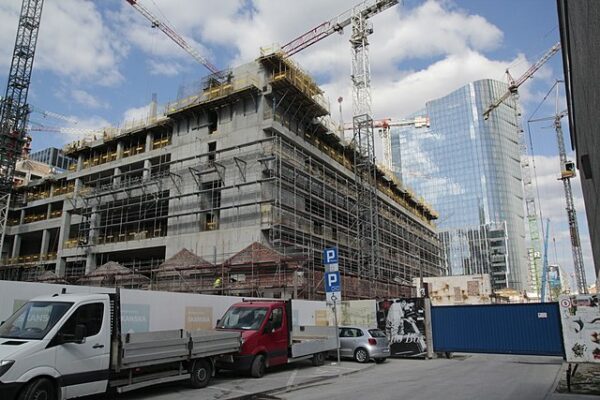American manufacturing has typically been seen over the past few years as part of a bygone era. But, following the COVID-19 pandemic and the realization that supply chains aren’t nearly as strong as expected, American businesses are coming home.
The trend is revealing itself in construction projects all over the country.
“A building boom in industrial plants, infrastructure and other nonresidential projects is offsetting home construction in the U.S. that has been weakening under the weight of higher interest rates. Contractors said spending on nonresidential projects has stayed strong as borrowing costs rise, which usually drives up the cost of financing construction work,” The Wall Street Journal explains.
Spending on nonresidential construction for February, the most recent month available, totaled $982 billion, nearly 17% higher than a year earlier and steady with January, according to the U.S. Census Bureau.
‘I’ve got more work to look at and bid on than I could possibly handle,’ said Jeff Harper, president of Harper Construction Co. in San Diego. ‘I’ve said ‘no’ to 10 jobs in the last four months.’
Mr. Harper, whose company specializes in buildings for schools, universities and military bases, said he is booked with jobs through most of 2024. He said projects are taking longer to complete because of waits for critical materials, particularly for electrical gear, and shortages of workers.”
The newspaper recently had a long read titled “America is back in the factory business” about how factories are returning to the United States.
“Manufacturing has always been an integral part of American life. Paul Revere opened a foundry that produced bells and cannons following his famous midnight ride. Henry Ford’s assembly line made cars affordable to the masses. And U.S. industrial might helped win World War II, when nearly half of private-sector employees worked in factories.
That portion plunged after the war, thanks to automation and U.S. companies seeking lower costs overseas. Production capacity, which had grown at about 4% a year for decades, flattened after China’s 2001 entry into the World Trade Organization.
But last year U.S. production capacity showed its strongest growth since 2015 after pandemic-driven shortages and delays caused manufacturers to rethink their far-flung supply chains, said UBS industrials analyst Chris Snyder.
“Covid kind of pulled the covers off and showed everybody how much risk they were exposed to,” Mr. Snyder said.
Today U.S. manufacturing employment is holding steady at about 10% of the private sector, according to the U.S. Bureau of Labor Statistics, with nearly 800,000 jobs added in the sector over the past two years. The total number, 13 million, was virtually unchanged in the latest BLS jobs report.”
Last summer, Mckinsey wrote, “Today, US manufacturing has reached an inflection point. The decade leading up to the COVID-19 crisis saw the sector recover some of its earlier declines: 1.3 million manufacturing jobs were added to the economy between 2010 and 2019, following the loss of 5.8 million jobs over the previous ten years. The country’s share of global manufacturing GDP, output, and exports also stabilized.
Accelerating that upturn could have transformative economic and social effects while improving the resilience of the wider economy. Analysis by the McKinsey Global Institute suggests that restoring growth and competitiveness in key manufacturing industries could boost US GDP by more than 15 percent over the rest of the current decade.
A strong manufacturing economy unlocks important employment and advancement opportunities—a factor set to grow in significance if current job market pressures ease. Manufacturing is the main economic engine and primary employer in around 500 US counties today, and in those communities, the industry employs a broader-than-average swath of the overall population and does so more inclusively. In most cases, employees don’t need four-year degrees, and they can earn twice as much as those holding equivalent service-sector jobs, as employers invest in upskilling and reskilling their current workers by offering expanded learning opportunities. Our analysis suggests that reviving manufacturing could add up to 1.5 million jobs, particularly among middle-skill workers, which would help recalibrate the US labor market and bolster the middle class.
Strengthening the sector could also address the supply chain issues that have been wreaking economic havoc over recent years, easing disruptions caused by the pandemic while improving global competitiveness in the mid to long term. Between 2010 and 2019, the US trade deficit in manufactured goods more than doubled, reaching $883 billion. The country currently meets 71 percent of its final demand with regional goods, trailing Germany (with 83 percent), Japan (86 percent), and China (89 percent). Increased import dependence has left some key US manufacturing supply chains exposed to greater global risks. The supply chain shocks of the past three years have pushed those risks to the top of the corporate agenda: in surveys, more than 90 percent of senior executives tell us that increasing the level of resilience in their supply chains is a priority.”
That means more work for everyone who can swing a hammer and work construction.



